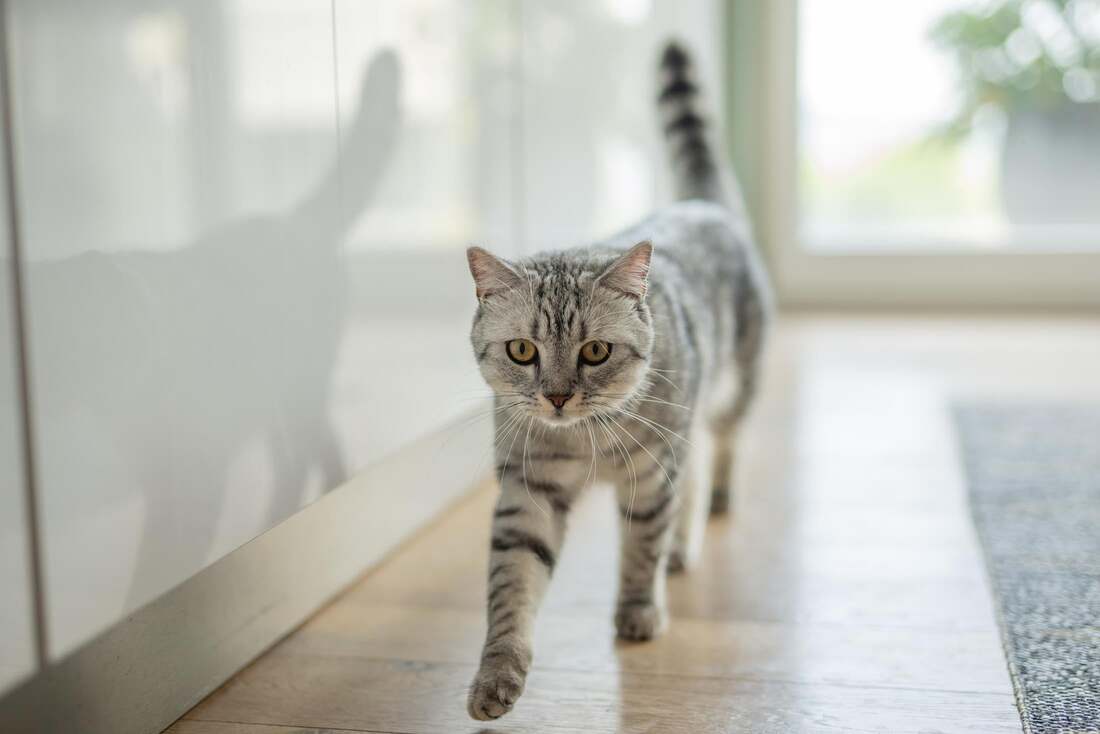Have you ever wondered when the right time is to have your male cat neutered? Between wanting to do what's best for your furry friend and the numerous opinions, it can be hard to make a decision. Generally, male cats can be neutered from around 6 months of age.
In this article, we take a comprehensive look at everything you need to know about neutering your male cat – from the benefits and disadvantages to the costs and aftercare.
Early castration of tomcats: When is the best time?

Early castration of tomcats, i.e. castration before sexual maturity, has many advantages. It can be carried out as early as 4 to 8 months of age, depending on the breed and individual development of the animal. This procedure prevents unwanted offspring and can reduce the risk of certain diseases. It can also reduce aggressive behavior or urine marking, which is particularly beneficial for indoor cats.
However, there are also some concerns about early castration. Critics point out that the cats' development may be different, which can lead to a duller coat and a higher risk of urinary stones. Nevertheless, studies and many years of experience show that the advantages outweigh the potential disadvantages. The decision for early castration should therefore always be made individually and in consultation with a veterinarian in order to ensure the best possible well-being of the tomcat.
Castration vs. sterilization: Which is better for your cat?
The choice between castration and sterilization is crucial for the well-being of your tomcat. Castration involves removing the testicles, which reduces the production of sex hormones and associated behaviors such as marking or aggression. Sterilization , in which only the sperm ducts are severed, prevents reproduction but leaves the hormonal balance and thus the behavior unchanged. For most cat owners, castration is therefore the better choice to effectively prevent both unwanted offspring and undesirable behavior.
Why castration? The advantages at a glance

Neutering your male cat has numerous advantages, both for the health of your pet and for your life together. One of the most important advantages is preventing uncontrolled reproduction. This is particularly important because a single cat and its offspring can produce thousands of kittens in just a few years, which leads to overpopulation and more cats in animal shelters. Furthermore, neutering significantly reduces the risk of certain hormonal diseases, such as ovarian or uterine diseases in cats and testicular or prostate diseases in male cats.
In addition to the health aspects, castration also has a positive effect on the behavior of your furry friend. Neutered cats and tomcats are often more trusting and develop a closer bond with their owners. They are less prone to aggressive behavior and territorial fights, which not only minimizes the risk of injury, but also makes living together with other cats easier. In addition, hormonally-related behaviors such as marking territory with smelly urine are eliminated . All of these advantages contribute to a more harmonious coexistence and increase the quality of life for both the cat and you as the owner.
Disadvantages of castration: What cat owners should know
Many cat owners are aware of the benefits of neutering their male cats, but there are also some potential disadvantages that should be considered. A common problem after neutering is weight gain . Since neutered cats have an altered metabolism, they tend to gain weight more quickly. This can lead to obesity if an adjusted diet and sufficient exercise are not taken care of. In addition, neutered male cats can display a calmer and less active behavior, which can be undesirable for some cat owners.
In addition to the behavioral changes and weight gain, there are also health complications that can occur, although they are rare. These include reactions to the anesthesia or infections at the surgical site. Many cat owners also worry about the natural development of their male cats and fear that neutering may affect it. It is important that cat owners are aware of these potential disadvantages and make an informed decision about whether neutering is the right choice for their male cat.
The Neutering Process: A Guide for Cat Owners
Castration of a male cat begins long before the operation takes place. Firstly, it is important that the male cat remains fasting from the evening before the operation to avoid complications during the anesthesia. Before the operation, the veterinarian carries out a thorough health check to ensure that the male cat is fit enough for the general anesthesia. This check-up is crucial because it provides information on whether all organs are functioning properly and whether the animal is healthy enough for the operation.
The actual surgical procedure is carried out under general anesthesia and usually only takes about half an hour. The cat's testicles are removed through two small incisions in the scrotum . This method is relatively uncomplicated and often does not require stitches, as the small incisions heal on their own. It is important that the area around the incisions is shaved and disinfected before the operation to avoid infections. After the operation, the cat can usually go home the same day and then only needs to recover from the anesthesia.
Aftercare after castration: How to support your tomcat

After your cat has been neutered, it is important that you know exactly what to do to help him heal. Your veterinarian will give you specific instructions that you should be sure to follow. These include:
- When and what your cat can eat and drink again .
- The administration of medication if necessary.
- How to care for the wound to avoid infection.
It is also important to look out for signs such as inflammation, unpleasant odor or severe swelling. If something is wrong, you must contact the vet immediately.
Another important step is to provide a quiet and comfortable place for your cat to rest and heal undisturbed. Make sure that he does not jump too much or be too active, as this can negatively affect the healing process. Neck collars or cat bodysuits can be helpful to prevent him from licking or biting the stitches, especially if dissolvable stitches were used. Keep in mind that the first twelve hours after surgery are critical and your cat may need more attention and care.
Costs of castration: A financial overview
The cost of castration can play an important role for cat owners when they consider whether and when they should have their tomcat neutered. In general, the costs vary depending on the vet, location and the health of the tomcat. However, the fee schedule for veterinarians provides a framework within which the prices can vary. For a tomcat castration, you can expect costs of between 30 and 100 euros , while the castration of a cat is more expensive due to the more complex procedure and can cost up to 170 euros . In addition to these costs, there may also be expenses for the preliminary examination, anesthetics and aftercare. It is important that you inform your vet about the costs involved before the procedure and consider the following points:
- General examination and consultation.
- Costs for anesthetic and injection.
- Surgical procedure and aftercare.
This financial overview is intended to help you make an informed decision and provide your cat with the best possible care.
Compulsory castration for cats: What you need to know
The obligation to neuter cats is an important issue for all cat owners. It was introduced to control the overpopulation of cats and to reduce the suffering of homeless cats. In many German cities and municipalities, this obligation is already a reality. As a cat owner, you are obliged to have your cat neutered to avoid uncontrolled reproduction. In concrete terms, this means:
- Your cat must be neutered at a certain age , which may vary depending on local regulations.
- You must be able to prove that your cat has been neutered, which can be done by an entry in the pet register or by presenting a medical certificate.
- Failure to comply with the castration requirement may result in fines .
These measures are designed to protect cats and help ensure that fewer animals end up on the streets or in animal shelters. As a responsible cat owner, you should therefore find out about the specific requirements in your region and act accordingly.
Personality change after castration: myth or truth?

Many cat owners worry that neutering will change their male cat's personality. But is that really the case? In fact, many owners report that their male cats change for the better after neutering. They often become more trusting and less aggressive, making living together more pleasant. These changes are usually due to the reduction in sex hormones, which can have a strong influence on behavior. It is important to understand that every cat is unique and therefore not all male cats will behave in the same way, but chances are good that neutering will lead to a more peaceful relationship.
In addition to the benefits already mentioned, neutered male cats can also show other positive behavioral changes:
- They are less likely to defend their territory through urine marking.
- The risk of territorial fights with other cats is reduced.
- They often develop a closer bond with their humans.
However, it is important to note that weight gain may also occur, as neutered male cats have an altered metabolism. This means that cat owners should keep an eye on their male cat's diet and activity levels to avoid obesity. In short, neutering can lead to a number of positive changes that can improve both the male cat's quality of life and living with him.
How Flappies Smart Cat Flap Can Support the Neutering of Your Male Cat
After neutering your male cat, there may be behavioral changes that may also affect his outdoor behavior. This is where Flappie's smart cat flap comes in, making life easier for you and your male cat. Through selective access control and prey detection, Flappie ensures that your male cat comes home safely without bringing any unwanted "gifts" with him. This can be especially useful if your male cat becomes less aggressive after neutering and you want to make sure he doesn't get into fights or bring home prey.
The Flappie app offers additional support by allowing you to monitor and control your cat's comings and goings. After neutering, it is important to monitor the cat a little to make sure he is recovering well and his behavior is adjusting as expected. With features like:
- Push notifications when your cat uses the flap,
- Photos and videos from his trips,
- By collecting statistics on his behavior , you can give your cat the freedom he loves while keeping an eye on his well-being.
Frequently Asked Questions
Can you neuter a tomcat too early?
Early castration of male cats can be carried out as early as 4 to 8 months of age, depending on the breed and individual development of the animal. There are concerns about the development of cats after early castration, such as duller fur and a higher risk of urinary stones. However, studies and many years of experience have shown that the advantages outweigh the potential disadvantages. An individual decision in consultation with a veterinarian is important.
How much does it cost to castrate a tomcat?
The cost of castrating a male cat can vary between 30 and 100 euros. These costs can vary depending on the vet, location and the health of the male cat. In addition to the costs, there may be expenses for the preliminary examination, anesthetics and aftercare.
Can you neuter a tomcat at 2 years old?
The blog post does not directly specify an upper age for neutering a male cat, but it does generally state that male cats can be neutered from around 6 months of age. Neutering at a later age, such as at 2 years of age, is generally possible, but should be discussed individually with a veterinarian to ensure the animal's well-being.





Share:
"Cat Hunting": Insight into its Hunting Behavior
How old do Persian cats get? A comprehensive guide